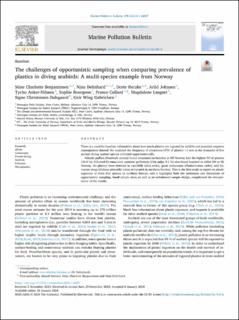| dc.contributor.author | Benjaminsen, Stine Charlotte | |
| dc.contributor.author | Dehnhard, Nina | |
| dc.contributor.author | Herzke, Dorte | |
| dc.contributor.author | Johnsen, Arild | |
| dc.contributor.author | Anker-Nilssen, Tycho | |
| dc.contributor.author | Bourgeon, Sophie | |
| dc.contributor.author | Collard, France | |
| dc.contributor.author | Langset, Magdalene | |
| dc.contributor.author | Christensen-Dalsgaard, Signe | |
| dc.contributor.author | Gabrielsen, Geir W. | |
| dc.date.accessioned | 2024-01-24T12:59:56Z | |
| dc.date.available | 2024-01-24T12:59:56Z | |
| dc.date.created | 2024-01-19T08:59:39Z | |
| dc.date.issued | 2024 | |
| dc.identifier.citation | Marine Pollution Bulletin. 2024, 199, 116037. | en_US |
| dc.identifier.issn | 0025-326X | |
| dc.identifier.uri | https://hdl.handle.net/11250/3113594 | |
| dc.description.abstract | There is a need for baseline information about how much plastics are ingested by wildlife and potential negative consequences thereof. We analysed the frequency of occurrence (FO) of plastics >1 mm in the stomachs of five pursuit-diving seabird species collected opportunistically. Atlantic puffins (Fratercula arctica) found emaciated on beaches in SW Norway had the highest FO of plastics (58.8 %), followed by emaciated common guillemots (Uria aalge; 9.1 %) also found beached in either SW or SE Norway. No plastics were detected in razorbills (Alca torda), great cormorants (Phalacrocorax carbo), and European shags (Gulosus aristotelis) taken as bycatch in northern Norway. This is the first study to report on plastic ingestion of these five species in northern Europe, and it highlights both the usefulness and limitations of opportunistic sampling. Small sample sizes, as well as an unbalanced sample design, complicated the interpretation of the results. | en_US |
| dc.language.iso | eng | en_US |
| dc.publisher | Elsevier | en_US |
| dc.rights | Navngivelse 4.0 Internasjonal | * |
| dc.rights.uri | http://creativecommons.org/licenses/by/4.0/deed.no | * |
| dc.title | The challenges of opportunistic sampling when comparing prevalence of plastics in diving seabirds: A multi-species example from Norway | en_US |
| dc.type | Peer reviewed | en_US |
| dc.type | Journal article | en_US |
| dc.description.version | publishedVersion | en_US |
| dc.rights.holder | © 2024 The Authors | en_US |
| dc.subject.nsi | VDP::Zoologiske og botaniske fag: 480 | en_US |
| dc.subject.nsi | VDP::Zoology and botany: 480 | en_US |
| dc.source.volume | 199 | en_US |
| dc.source.journal | Marine Pollution Bulletin | en_US |
| dc.identifier.doi | 10.1016/j.marpolbul.2024.116037 | |
| dc.identifier.cristin | 2229970 | |
| dc.relation.project | Norges forskningsråd 275172 | en_US |
| dc.source.articlenumber | 116037 | en_US |
| cristin.ispublished | true | |
| cristin.fulltext | original | |
| cristin.qualitycode | 1 | |

